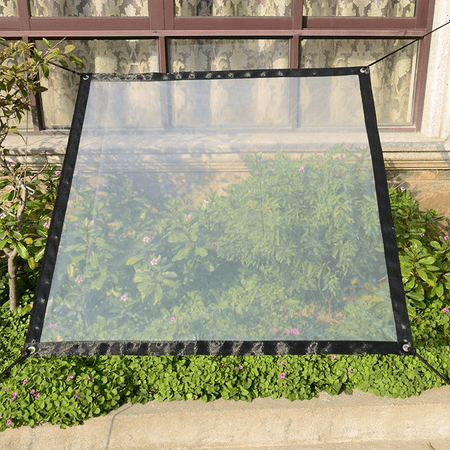How to Protect Plants From Wind — 6 Genius Tricks to Shield a Yard Against Gales
Expert advice on creating a yard that can withstand the wind

Weather patterns are changing, and gardeners realize this more than most. Although summer has its challenges with drought, winter can be beset with storms and howling winds. Understanding how to protect plants from wind, will not only help their survival, but may support surrounding structures too.
Hurricanes, cyclones and extreme weather aside, what can gardeners do to shield the plants in their backyards from gusts and gales?
'There are many things that can be done to provide a degree of protection for your garden against excessively strong winds, even in the most exposed locations,' says Kim Stoddart, co-author, The Climate Change Garden.
1. Plant trees and bushes as wind breaks

Nature generally provides better barriers to the elements in a modern garden than those that are human-made. So consider planting hardy trees and bushes to shield smaller plants from biting winds.
'Planting trees and bushes as a wind break, rather than building a solid barrier, will take the sting out of the gale by slowing it down,' says Kim Stoddart. 'A complete barrier would reflect the wind away in another direction, potentially causing damage elsewhere, which is why walls and fencing make less desirable windbreaks.
'Plantings provide natural protection against the wind, and have the additional benefit of helping to soak up excess rainfall through their deep, wide-ranging roots. Suitable species include European Beech, Holly, Laurel, Common Hornbeam, Willow.'
2. Protect small plants with tall ones

Planting taller species next to smaller plants will also offer some protection against strong winds.
The Livingetc newsletters are your inside source for what’s shaping interiors now - and what’s next. Discover trend forecasts, smart style ideas, and curated shopping inspiration that brings design to life. Subscribe today and stay ahead of the curve.
'In the vegetable garden, taller produce such as artichoke thistle, sunflowers, Jerusalem artichokes, even runner beans can be used to provide a degree of protection to other plants there,' says Kim.
'Another option to consider are fruit bushes and trees to provide both functional and edible protection,' Kim adds. 'Protect taller produce in the vegetable patch by adding some bamboo canes for staked and tied support.'
3. Install a trellis or pergola

Garden structures that allow wind to blow through them will help to slow it down and reduce damage to plants nearby.
'A garden trellis with its spaced lattices, works to slow–rather than deflect–the wind, while an archway or pergola populated with climbing plants can provide another aesthetically pleasing defence,' says Kim.
4. Trim top-heavy plants
When the weather turns, or you're expecting a storm, there are some other precautions you can take to reduce potential damage to plants.
'If you have any top-heavy plants, consider trimming them back to reduce their wind resistance and help them ride out the storm,' says Kim.
5. Choose containers for vulnerable plants

Container gardening is another option, as having the flexibility to move particular plants or ornamental trees away from desiccating winds when they arrive will increase their chances of survival.
If you're unsure how a prized plant will cope in a windy part of your garden, start it off in a container and see how it fairs in that spot.
Plants can get wind scorched, which is where their leaves turn brown. If this is a possibility, move your plants to a sheltered part of your yard.
6. Create a burlap windscreen
Native plants tend to not need protecting in winter, as they are acclimatized to your region. If you have less hardy non-native species in your garden, they may need to be covered. Burlap is not an attractive look, however, it will provide some protection to your plants.
'Protect small, tender evergreens such as dwarf Alberta spruce from cold winds by creating a burlap windscreen,' says Charlie Nardozzi, author, Month-by-Month Gardening New England.
'In windy, exposed locations, and in areas where they are marginally hardy, plants such as rhododendron and mountain laurel can be easily winter injured too,' Charlies adds. 'Often the drying wind or salt spray from the ocean causes more damage than cold temperatures. The result is brown leaves in spring and a deformed shrub.
'To protect existing plants, drive four wooden or metal stakes into the ground around the shrub before the ground freezes. Wrap chicken wire around the stakes to enclose the shrub. Attach it to the stakes with plant ties or metal staples.
'Wrap burlap around the chicken wire to provide the windscreen. Make sure the burlap doesn’t touch the leaves. The burlap can wick moisture away from the leaves, adding to any damage.'
Jacky Parker is a freelance lifestyle journalist and writer, producing a wide range of features for magazines and digital platforms. She has written for Livingetc and its sister titles, Homes & Gardens and Country Homes & Interiors for more than 15 years, both as a freelance contributor and as Acting Digital Editor and Acting Style Content Editor, regularly reporting on the latest interiors, gardens and wellness inspiration, speaking to experts in their respective fields, and discovering the best tips.
Jacky has also written for other publications, including Sunday Times Style, The Telegraph, Architectural Digest, House Beautiful, ELLE Decoration, Red, Grand Designs and more.


